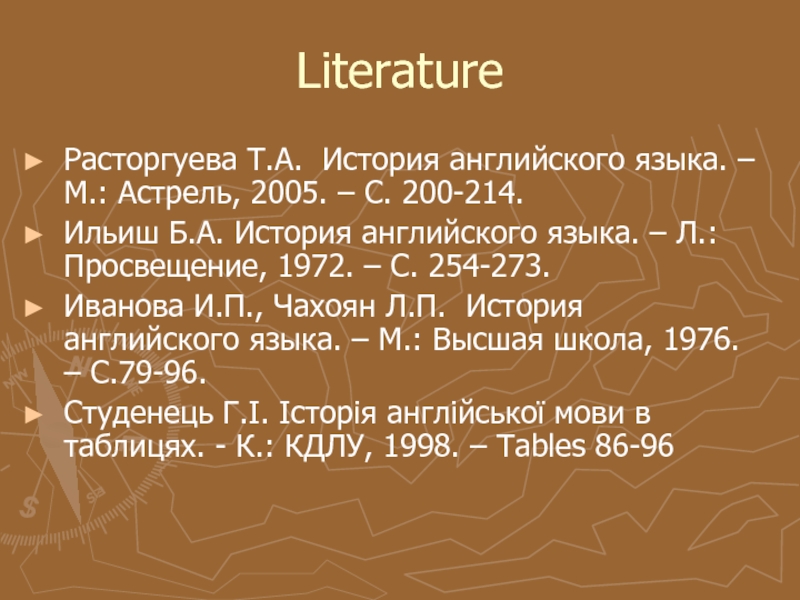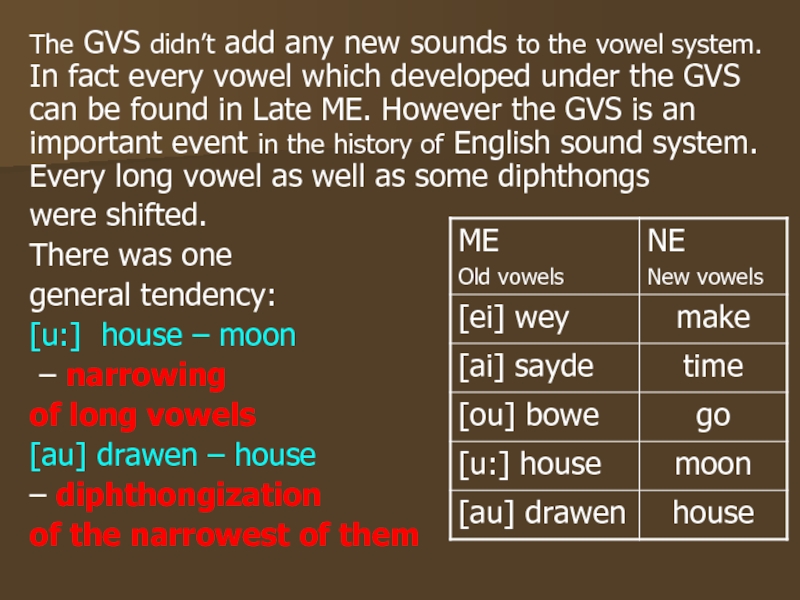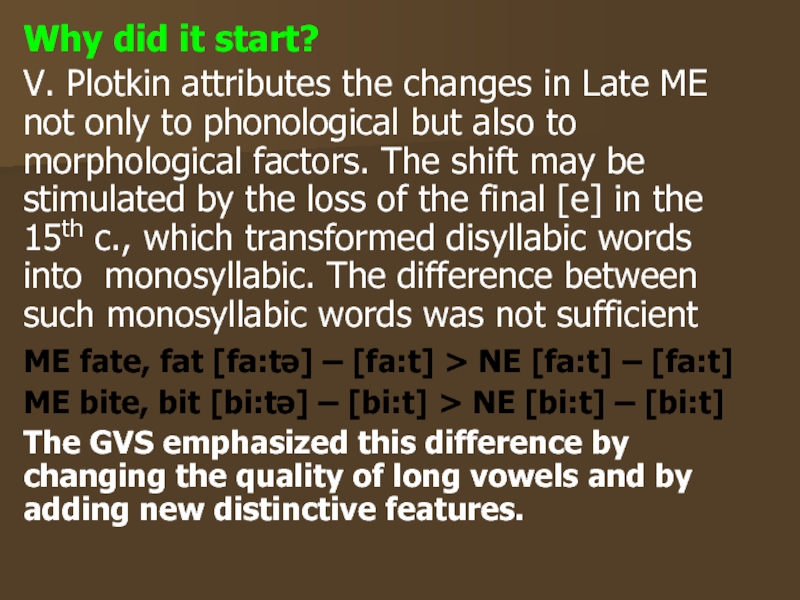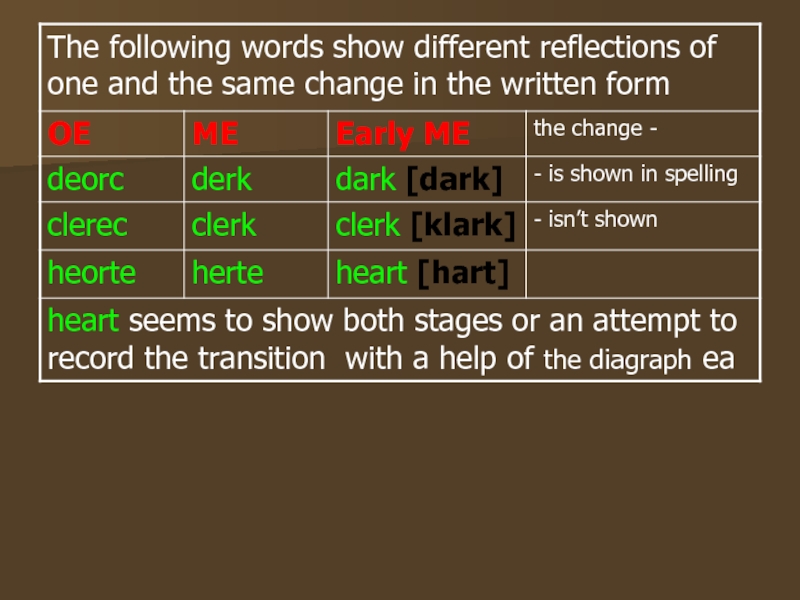Разделы презентаций
- Разное
- Английский язык
- Астрономия
- Алгебра
- Биология
- География
- Геометрия
- Детские презентации
- Информатика
- История
- Литература
- Математика
- Медицина
- Менеджмент
- Музыка
- МХК
- Немецкий язык
- ОБЖ
- Обществознание
- Окружающий мир
- Педагогика
- Русский язык
- Технология
- Физика
- Философия
- Химия
- Шаблоны, картинки для презентаций
- Экология
- Экономика
- Юриспруденция
KYIV NATIONAL LINGUISTIC UNIVERSITY
Содержание
- 1. KYIV NATIONAL LINGUISTIC UNIVERSITY
- 2. PlanThe Great Vowel Shift.The development of short
- 3. LiteratureРасторгуева Т.А. История английского языка. – М.:
- 4. The Great Vowel Shift (GVS)The most significant
- 5. i: → ai
- 6. The Great Vowel Shift (GVS)The process of
- 7. The Great Vowel Shift (GVS)These changes can
- 8. It must be noted that some of
- 9. The GVS didn’t add any new sounds
- 10. Some interpretations of the GVSThere are certainly
- 11. Push-chain (Luick). The changes started at open
- 12. Why did it start?V. Plotkin attributes the
- 13. Exceptions to the GVS: before [d], [t],
- 14. Development of short vowelsIn comparison with long
- 15. Слайд 15
- 16. Слайд 16
- 17. In EME vocalization of some fricatives led
- 18. Слайд 18
- 19. Слайд 19
- 20. Слайд 20
- 21. Loss of unstressed [ə]The loss of [ə]
- 22. Voicing of voiceless fricatives In OE
- 23. One phonetic condition – an unstressed preceding
- 24. In OE there were no affricates, sibilants
- 25. The stress moved closer to the beginning
- 26. Слайд 26
- 27. Слайд 27
- 28. THANK YOU FOR YOUR ATTENTION!
- 29. Скачать презентанцию
PlanThe Great Vowel Shift.The development of short vowels. Rise of new long vowels.Rise of new diphthongs and triphthongs.Consonant changes .
Слайды и текст этой презентации
Слайд 3Literature
Расторгуева Т.А. История английского языка. – М.: Астрель, 2005. –
С. 200-214.
Ильиш Б.А. История английского языка. – Л.: Просвещение, 1972.
– С. 254-273.Иванова И.П., Чахоян Л.П. История английского языка. – М.: Высшая школа, 1976. – С.79-96.
Студенець Г.І. Історія англійської мови в таблицях. - К.: КДЛУ, 1998. – Tables 86-96
Слайд 4The Great Vowel Shift (GVS)
The most significant phonetic change of
this period was the GVS (which involved the change of
all MEvowels and some of the diphthongs) between the 14th and 18th c.
All the long vowels became closer or were diphthongized
Слайд 5 i: → ai time [ti:mə] → [taim] e: →
i: keep [ke:p] → [ki:p] ɛ: → e: →
i: sea [sɛ:] → [se:] → [si:] a: → ei name, take ɔ: → ou go, boat o: → u: moon, tool u: → au out, nounСлайд 6The Great Vowel Shift (GVS)
The process of change was gradual.
Each stage took more
than 100 years.
Слайд 7The Great Vowel Shift (GVS)
These changes can be defined as
“independent” as they were not caused by any phonetic conditions.
GVS – is an additional source of diphthongs in NE.The difference between spellings lost its phonetic value ea [ɛ:] - ee [e:].
In the 17th century began to serve to distinguish between two words pronounced in the same way
(see- sea, week – weak, meat -meet )
Слайд 8It must be noted that some of the diphthongs which
appeared during the GVS could appear from other sources. The
diphthong [ou] was preserved from ME without modifications.[ei] originates from the ME [ai/ei] which had merged into one diphthong.
The GVS (unlike other most of the earlier phonetic changes) wasn’t followed by any regular spelling changes.
During the shift even the names of some English letters were changed.
Слайд 9The GVS didn’t add any new sounds to the vowel
system. In fact every vowel which developed under the GVS
can be found in Late ME. However the GVS is an important event in the history of English sound system. Every long vowel as well as some diphthongswere shifted.
There was one
general tendency:
[u:] house – moon
– narrowing
of long vowels
[au] drawen – house
– diphthongization
of the narrowest of them
Слайд 10Some interpretations of the GVS
There are certainly many remarkable aspects
in the shift. It left no long vowel unaltered.
All vowels changed in a single direction.How did the GVS start?
Drag-chain theory
(Jespersen) ME [I:], [u:]
diphthongized first and
the mid vowels [e:], [o:]
moved up into their vacate positions dragging after them selves their neighbors.
Слайд 11Push-chain (Luick). The changes started at open vowels every step
pushed
the adjoining vowel away to avoid coincidence the lower
ones moved up into their slots.When did it start?
A.Martinet, B.Trnka: The GVS began in the 12th- 13th century when two short vowels [i], [u] became more open.
H. Sweet, O. Jespersen: 16-18 c.
R. Lass : 1500
Слайд 12Why did it start?
V. Plotkin attributes the changes in Late
ME not only to phonological but also to morphological factors.
The shift may be stimulated by the loss of the final [e] in the 15th c., which transformed disyllabic words into monosyllabic. The difference between such monosyllabic words was not sufficientME fate, fat [fa:tə] – [fa:t] > NE [fa:t] – [fa:t]
ME bite, bit [bi:tə] – [bi:t] > NE [bi:t] – [bi:t]
The GVS emphasized this difference by changing the quality of long vowels and by adding new distinctive features.
Слайд 13Exceptions to the GVS:
before [d], [t], [n], [v], [θ]:
dead, head, threat, wealth, friend etc.
ea [ɛ:] >[e:] did
not take the step to [i:], it was stopped by the preceding [r]: break, greatVowels in the words borrowed later remained unchanged: police, machine, group
Слайд 14Development of short vowels
In comparison with long vowels, other changes
seem few and insignificant. Short vowels were more stable than
long vowels. Only two out of five underwent certain alterations (a, u).Слайд 17In EME vocalization of some fricatives led to the appearance
of long monophthongs and new diphthongs.
[X], [X΄] had been
vocalized by Late ME.ME taughte [ˊtauxtə] > [to:t] – [au] was contracted to [o:] and [x] was lost.
ME night [niX΄t] > [nijt] > [ni:t] > [nait].
The most important instance of vocalization is the development of [r]. The sonorant [r] made the preceding vowel more open, retracted [er > ar].
Слайд 21Loss of unstressed [ə]
The loss of [ə] started in the
Northern dialects. By the 14th c. it was completed.
It was
final (love [luv])When it was followed by a consonant (tables, hats, books, lived, stopped)
The sound [ə] is still pronounced in the endings where its falling off could cause difficulties of articulation and understanding. Later [ə] > [I] (horses, bushes)
Слайд 22Voicing of voiceless fricatives
In OE the pairs of
fricative consonants [f]-[v], [θ]-[ð], [s]-[z] were treated as positional variants.
Sonority depended on the phonetic conditions. Phonologization of voiced and voiceless fricatives was a slow process which lasted several hundred years. [f]-[v] were the first to turn into phonemes (ME veyne [΄veinə] – feign [΄feinə]). In the 16th c. the fricatives were voiced under certain conditions:when they were preceded by an unstressed vowel;
followed by a stressed vowel.
Слайд 23One phonetic condition – an unstressed preceding vowel was sufficient
to transform a voiceless into a voiced one.
Voiced and voiceless
fricatives began to appear in similar phonetic conditions and could be used for phonological purposes (to distinguish different morphemes).ice [ais] – eyes [aiz]
rice [rais] – to rise [raiz]
teeth [ti:θ] – to teeth [ti:ð]
Слайд 24In OE there were no affricates, sibilants (except s, z)
In
Late ME palatal [k’], [g’], [sk’] developed in [t∫], [dʒ],
[∫] (ME child, each, ship, shinen + French borrowings, e.g. charme [t∫armə]).The opposition of velar and palatal consonants disappeared, instead plosives were contrasted to new affricates ([t∫] - [dʒ], [∫] - ?).
New affricates, sibilants appeared in Early NE as a result of the phonetic assimilation of lexical borrowings.
In many French borrowings the stress fell on the last syllable (ME nacioun [na΄sju:n], plesure [ple΄zju:r]).




![KYIV NATIONAL LINGUISTIC UNIVERSITY i: → ai time [ti:mə] → [taim] e: → i: → ai time [ti:mə] → [taim] e: → i: keep](/img/thumbs/d2fc7d0ab02687756f334bf41e24385a-800x.jpg)







![KYIV NATIONAL LINGUISTIC UNIVERSITY Exceptions to the GVS: before [d], [t], [n], [v], [θ]: dead, Exceptions to the GVS: before [d], [t], [n], [v], [θ]: dead, head, threat, wealth, friend etc. ea](/img/thumbs/58c28feca2ab380e4a173856285c55ed-800x.jpg)



![KYIV NATIONAL LINGUISTIC UNIVERSITY In EME vocalization of some fricatives led to the appearance of In EME vocalization of some fricatives led to the appearance of long monophthongs and new diphthongs. [X],](/img/thumbs/fc1e1fc1d76339281f644405af0e064b-800x.jpg)



![KYIV NATIONAL LINGUISTIC UNIVERSITY Loss of unstressed [ə]The loss of [ə] started in the Northern Loss of unstressed [ə]The loss of [ə] started in the Northern dialects. By the 14th c. it](/img/thumbs/993179a5c05605985ddf5ffd4a5c9253-800x.jpg)
![KYIV NATIONAL LINGUISTIC UNIVERSITY Voicing of voiceless fricatives In OE the pairs of fricative consonants Voicing of voiceless fricatives In OE the pairs of fricative consonants [f]-[v], [θ]-[ð], [s]-[z] were treated](/img/thumbs/f3de86a55e5ae8d698d42f151f8f9f2d-800x.jpg)

![KYIV NATIONAL LINGUISTIC UNIVERSITY In OE there were no affricates, sibilants (except s, z)In Late In OE there were no affricates, sibilants (except s, z)In Late ME palatal [k’], [g’], [sk’] developed](/img/thumbs/86b45a178d646663ecffb98ec795ee8c-800x.jpg)























